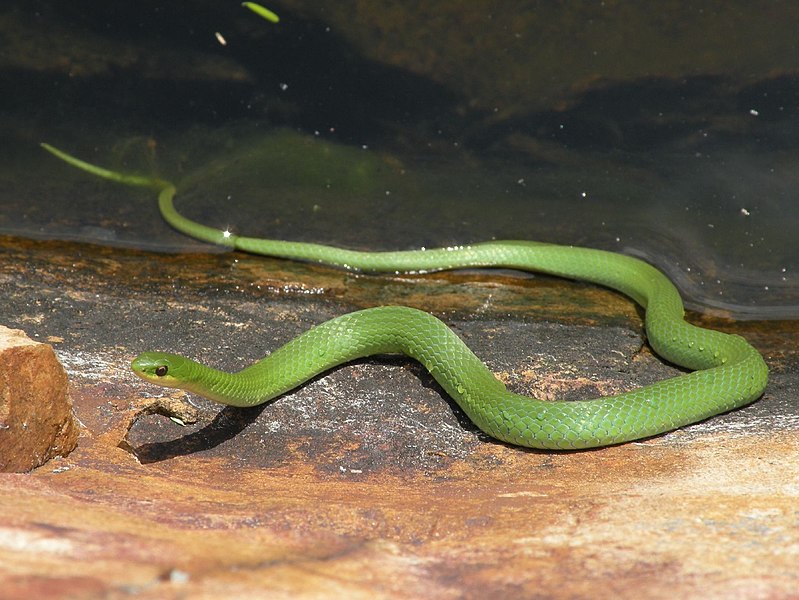 Please see Part 1 of this article for more on the natural history and care of Rough and Smooth Green Snakes (Opheodrys aestivus and O. vernalis).
Please see Part 1 of this article for more on the natural history and care of Rough and Smooth Green Snakes (Opheodrys aestivus and O. vernalis).
Heat
An ambient temperature of 70-76 F is ideal. A basking site of 80-85F should be available as well.
Light
There is some evidence that, in contrast to most snakes, Green Snakes benefit from exposure to UVB light. A moderate-output bulb, such as the Zoo Med 2.0 should be provided.
As with most diurnal animals, Green Snakes will also benefit from the provision of a UVA-emitting bulb (incandescent UVA bulbs will also provide heat for the basking site).
Diet
Green Snakes are more difficult to provide for than typical rodent-eating species, but well worth the effort. Those who do well with these snakes have one thing in common – they consistently provide a highly-varied diet. Green Snakes will not thrive for long on crickets alone…during times when they are a mainstay, crickets themselves be well-fed before being offered to the snakes.
Wild-caught grasshoppers, smooth (non-hairy) caterpillars, moths, crickets, tree crickets, katydids, beetle grubs and harvestman (“daddy longlegs”) should comprise the bulk of Green Snake diets whenever possible. They take a great many spiders as well, but I hesitate to recommend collecting these to folks unfamiliar with potentially dangerous species.
Other commercially available insects that can be tried include roach nymphs, waxworms, newly-molted (white) mealworms and super mealworms, butter worms and silkworms. Canned silkworms may also offered via feeding tongs, but many Green Snakes are reluctant to feed in this manner.
Green Snakes have high metabolisms and should be fed 3-4 times weekly; in contrast to most snakes, they decline rapidly in condition if not fed often.
Drinking water is essential – more so than for most snakes. A water bowl should always be present, but some individuals will drink only from drops sprayed onto leaves and branches.
Further Reading
Green Snake fans usually favor Garter Snakes as well; please see Meet the Garter Snakes for more info.
Further natural history information may be found in this article.
Learn more about collecting insects here: Collecting Insects
Smooth Green Snake image referenced from wikipedia and originally posted by atrahamrepol and Ravedave
 That Reptile Blog – Reptile, Amphibian and Exotic Pet Care and Information
That Reptile Blog – Reptile, Amphibian and Exotic Pet Care and Information



I just got a smooth green tree snake the other day, it had been eating only crickets with no UVB. Your list of good feeder insects is going to be very helpful in ensuring this snake stays alive!
Hello, Frank Indiviglio here.
Thanks for your interest in our blog and the kind words. Toads are very aware of their surroundings and so it was likely exploring – they are quite bold (seems they “know” they are protected by skin toxins) and so usually calm down quickly.
Good luck and please keep me posted.
Best regards, Frank Indiviglio.
Hello Danielle, Frank Indiviglio here.
Thanks very much for the kind words! Enjoy your snake and please let me know if I can be of any further help.
Good luck and please keep me posted.
Best regards, Frank Indiviglio.
Hello I recently started keeping a rough green snake. Right now I’m feeding him every other day but how much should I be giving him exactly? Hard to tell how much is enough since he’s different from most snakes as well as lizards. Also how do I provide him with water? Would a bowl be adequate?
Hello Jake,
Every other day is generally fine, but feeding is affected by type of food, temperature, age, etc. But within reason, they are good at regulating metabolism to meet food availability; pl feel free to send more details re diet etc.
Sray tank daily…it will drink a bit that way, but provide a water bowl as well. best, Frank